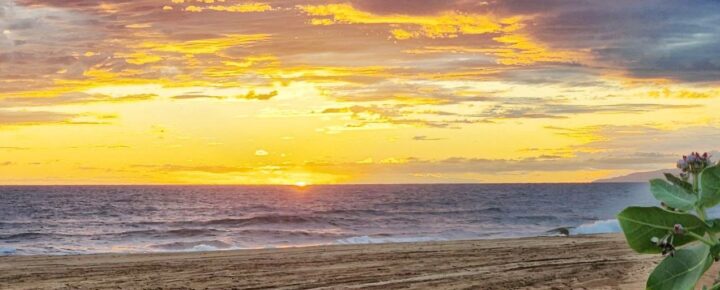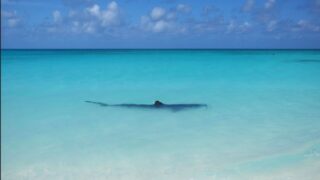Celebrated for its serene beauty and uncrowded waves, this Hawaii beach has developed a reputation for frequent shark sightings and occasional attacks. There has been a yearly shark incident here since 2020; the most recent they just took place was in November 2024.
While shark incidents occur throughout Hawaiian waters, the recurring activity at this particular beach raises questions about what makes it unique.


A timeline of shark incidents at Kekaha Beach.
Kekaha Beach on the West Side of Kauai and the nearby Davidson’s surf spot have experienced a series of shark-related incidents over the years. These incidents include both sightings and attacks, raising questions about the activity in this area.
The most recent Kekaha shark incident occurred in late November 2024, when a 10-foot tiger shark was sighted feeding near the shoreline at Intersections surf break. Although no injuries occurred, lifeguards closely monitored the situation, and warning signs were posted. Beach activities were halted for 24 hours as is the normal protocol here in Hawaii.
Last year, in July 2023, a suspected tiger shark, approximately 8 feet long, was seen in the area too, which led to warnings for ocean users and another beach closure.
Then, in January 2022, multiple sharks were spotted near Kekaha Beach’s shoreline, prompting officials to advise against swimming.
Back in November 2021, a shark measuring 8 to 10 feet chased a diver to shore near the surf break. Luckily, no injuries were reported.
In June 2020, another shark bite occurred at Davidson’s, this time injuring a local surfer’s hand. Safety advisories were issued immediately.
The beach went without shark sightings for three years. In April 2017, a 12-foot tiger shark bit a surfer at Davidson’s, resulting in severe leg injuries. The beach was temporarily closed for safety reasons.
What makes Kekaha Beach a shark hotspot?
Several environmental and behavioral factors may explain why Kekaha Beach experiences frequent shark activity.
Proximity to feeding grounds is one possible reason cited. Tiger sharks are opportunistic feeders drawn to areas rich in prey. Kekaha’s nearshore waters may harbor fish and marine life concentrations which result in increased shark activity.
The unique coastal features of the Intersections and Davidson’s surf breaks at Kekaha Beach create dynamic water movement. This activity attracts fish, which can then draw predators such as sharks.
Human activity in the area may also play a role. Kekaha’s surf spots see consistent human presence, particularly surfers and divers, which may increase the possibility of sightings and encounters.
Seasonal and migration patterns may also be contributory factors. Certain seasons, such as late summer and fall, often align with increased shark activity in Hawaiian waters. These periods may coincide with tiger sharks’ migratory or reproductive behaviors.
Staying safe at Kekaha Beach.
Shark incidents remain rare, and proper precautions can significantly reduce risks. The Kauai Ocean Safety Bureau regularly monitors the area to keep visitors safe. Visitors should always respect warnings and advisories issued by local officials or lifeguards. These warnings are based on real-time risks and should be followed.
Ocean activities should be planned for mid-morning to mid-afternoon, as sharks are more active during dawn and dusk hours. Avoid wearing shiny jewelry or brightly colored swimwear, as these can resemble prey in the water. Visitors should also consult on-duty lifeguards for the latest safety information and ocean conditions before entering the water.
Coexisting with sharks in Hawaii.
Shark encounters are a natural part of the Hawaiian Islands’ marine environment. Like all apex predators, tiger sharks play an essential role in maintaining the balance of the ocean’s ecosystem. By understanding their behavior and respecting their habitat, locals, and visitors can safely enjoy the waters of Kekaha Beach and throughout the state while appreciating the beauty of Hawai‘i’s marine life.
While there’s likely no single cause for the frequent shark activity at Kekaha Beach, a combination of factors may play a role in this intriguing—and at times alarming—phenomenon.
Please share both your Kekaha beach and shark stories.
Get Breaking Hawaii Travel News







Good to know!!!
Yikes! I live nearby and was aware of the 2017 attack, but not the frequent sightings since almost every year. I wonder if the dredging (which altered currents and eroded part of beach east of the lifeguarded area near St. Theresa’s) to deepen Kikiaola small boat harbor has also brought in more fish to attract the sharks?
I believe a contributing factor to the presence of sharks in this area is clearly outlined in your Nov. 24th report of Kauai Shrimp. The discharge of effluent from their operation attracts fish searching for food and the fish attract more sharks. Kekaha beach is a beautiful spot and I still visit every year when I’m on the island. Last year though, I was sitting on the beach at the far west end and the stench was overpowering. It smelled like a rotten fish market. The county has to hold these shrimp farms accountable. Not only for attracting more sharks, but polluting the ocean, damaging the reefs and fouling the air.
OMG
Yes, my guess is the pumping of waste water from the Mana plains including the shrimp farms attracts marine life.
go on Google Earth to see the plumes of filthy water being pumped out. Use the “date” future to see each ditch. The pumps don’t run 24/7.
This massive ditch system was created to allow the sugar industry to plant the Mana plain. Before the pumping it was a lake/swamp from Waimea to Mana village. People used to canoe from Mana to Waimea.
If you quit pumping it will return to a lake/swamp.
I once witnessed what seemed to be a lot of tilapia (I don’t fish) washed out on the pumping at the ditch just south of the Kinikini runway on the base. Fresh water fish were littered dead on the beach. Small sharks were busy actually crawling up on the beach and snatching fish. Crazy.
Funny how you don’t hear this issue raised. Money talks.
Hey, if you”re a shark it is a great place for free take out food to go.
The park and beach offer a relaxed, uncrowded atmosphere that’s perfect for an easy laid-back visit. Parking is free and right in front, which is a convenient bonus. Be mindful that the waves here can be strong, but the presence of a lifeguard provides added safety. You’ll also find several covered picnic table areas, making it a great spot to enjoy a meal or simply take in the scenery.
Kekaha Beach Park is a total gem! Broad sand, great water but some rocks. It’s perfect for relaxing and enjoy views of Niihau.
This is one of my favorite hideaway beaches on Kauai. Never even knew about sharks there.